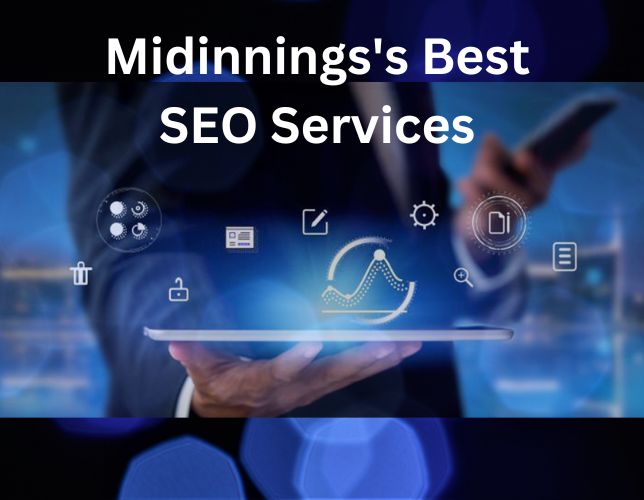
Midinnings: Best Digital Marketing Company In Udaipur
Midinnings provides a wide range of services to help clients reach their marketing objectives. To remain competitive, it’s critical for firms to stay up-to-date on the latest marketing trends. In Udaipur and the surrounding areas, the business is renowned for providing the best SEO services. The business offers a range of digital marketing services to its customers, who want to use those tactics to expand their enterprises. Leading website development business Midinnings has a reputation for offering top-notch services across various industries, including social media marketing, digital marketing, and SEO services. Both established companies and startups can benefit from our experienced solutions.

What is SEO?
SEO stands for Search Engine Optimization. It is the practice of optimizing a website in order to improve its ranking in search engine results pages (SERPs). SEO aims to make a website more visible and easier to find by users who are searching for keywords related to the website’s content. There are many different factors that can affect a website’s ranking, including the quality and relevance of its content, the structure, and organization of its pages, and the use of keywords in its headlines and tags. By improving these factors, it is possible to increase the visibility of a website and attract more traffic from search engines. This can be done through a variety of techniques, including keyword research, on-page optimization, and link building.

Midinnings SEO Services
1. Keyword Analysis
2. Keyword Assignment
3. On-site Seo Code Optimization
4. On-site Content Seo
5. On-site Internal Link Optimization
6. Advance Search Engine Optimization And External Link

1. Keyword Analysis: Keyword analysis is the process of identifying and evaluating the keywords and phrases that are relevant to a business or website. It is an important part of search engine optimization (SEO) and is used to help improve the ranking of a website in search engine results pages (SERPs).
There are several steps involved in keyword analysis:
- Identifying the target audience: The first step in keyword analysis is to identify the target audience for the website or business. This will help determine the types of keywords and phrases that are likely to be used by potential customers.
- Researching relevant keywords and phrases: There are a number of tools and techniques that can be used to research relevant keywords and phrases, such as keyword research tools, competitor analysis, and customer feedback.
- Evaluating the competitiveness of keywords: Once a list of potential keywords and phrases has been compiled, it is important to evaluate how competitive each keyword is. This can be done using tools such as the Google AdWords Keyword Planner or by analyzing the websites of competitors.
- Selecting the most appropriate keywords: Based on the research and evaluation, the most appropriate keywords should be selected for use on the website or in marketing campaigns.
- Tracking and analyzing the performance of keywords: It is important to track and analyze the performance of keywords over time in order to determine which ones are the most effective and make any necessary adjustments.
A keyword analysis is an ongoing process, and it is important to regularly review and update the keywords being used in order to ensure that they are still relevant and effective.

2. Keyword Assignment: Keyword assignment is the process of assigning specific keywords or phrases to individual pages or elements of a website or marketing campaign. This helps search engines understand the content and purpose of each page, which can affect the ranking of the page in search engine results pages (SERPs).
There are several best practices to follow when assigning keywords:
- Use relevant and specific keywords: It is important to use keywords that are relevant to the content of the page and specific to the business or website. This will help improve the relevance and credibility of the page.
- Use a mix of broad and specific keywords: A mix of broad and specific keywords can help attract a wider range of potential customers while still maintaining relevance.
- Use variations of keywords: Using different variations of a keyword, such as singular and plural forms, can help improve the visibility of a page.
- Use modifiers: Adding modifiers, such as “best,” “review,” or “comparison,” to keywords can help make the page more visible for long-tail searches.
- Use keyword phrases: Using keyword phrases, rather than single keywords, can help improve the relevance and specificity of the page.
It is important to carefully consider which keywords to assign to each page and to use them in a way that is natural and relevant to the content of the page. Overusing or stuffing keywords can have a negative effect on the ranking of a page.

3. On-site SEO Code Optimization: On-site SEO (Search Engine Optimization) refers to the practice of optimizing the elements of a website in order to improve its ranking in search engine results. This can include things like optimizing the site’s HTML code, as well as it’s content and images.
Some specific techniques for on-site SEO code optimization include:
- Properly formatting and structuring the HTML code, including using header tags (H1, H2, etc.) correctly and using a logical hierarchy of headings.
- Using alt text to describe images, which can be read by search engines and screen readers and help improve accessibility and search engine visibility.
- Ensuring that the website’s URLs are search-engine friendly, and use hyphens to separate words rather than underscores.
- Minifying the code, by removing unnecessary characters and whitespace, can reduce the size of the code and help to improve page load times.
- Optimizing the website’s meta tags, including the title tag and meta description, provides information to search engines about the page’s content.
- It’s important to keep in mind that on-site SEO is one aspect of SEO, there are also off-site SEO techniques and it’s important to consider both of them to get the best SEO results.

4. On-site Content SEO: On-site Content SEO refers to the practice of optimizing the content of a website to improve its ranking in search engine results.
Some specific techniques for on-site content SEO include:
- Conducting keyword research to identify relevant keywords and phrases to target, and then incorporating those keywords into the content in a natural way
- Creating high-quality, unique, and valuable content that is well-written and informative, and that addresses the needs of the website’s target audience.
- Optimizing meta tags, such as the title tag and meta description, which provide information to search engines about the page’s content and can be used to influence the way the page appears in search engine results.
- Creating content that is easy to read, with clear headings and subheadings, and using a logical structure that makes it easy for users to find the information they are looking for.
- Building internal links to other pages on the website can help to improve the visibility of those pages and increase the amount of time users spend on the site.
- It’s important to note that the quality and relevance of the website’s content will be a key factor in determining how well the site will rank in search engine results. High-quality, informative and relevant content is the foundation of on-site SEO.

5. On-site Internal Link Optimization: On-site internal link optimization refers to the practice of organizing and structuring the links within a website in a way that can help improve its visibility in search engine results.
Some specific techniques for on-site internal link optimization include:
- Creating a clear and logical website structure, using clear headings, categories, and a hierarchy of pages.
- Creating a sitemap that provides a clear overview of all the pages on the website and their relationship to each other, can help search engines understand the site’s content and index it more effectively.
- Building internal links from one page to another, which can help to distribute page authority and ranking power throughout the site and improve the visibility of less-prominent pages.
- Use descriptive and informative link texts, that help search engines understand the context of the linked page.
- Avoiding broken links within the website, and ensuring that all links are working properly and redirecting to the correct page. Creating a good internal link structure for a website can help users navigate the site easily, it also helps search engines understand the website’s structure and content, and to find new pages more easily. It’s important to note that internal linking can be beneficial for both website’s users and SEO.

6. Advance Search Engine Optimization and External Linking: Advanced search engine optimization (SEO) includes a variety of techniques and strategies that go beyond the basics of on-site optimization to improve a website’s visibility in search engine results. One important aspect of advanced SEO is external link building. External link building refers to the practice of acquiring links from other websites to your own. These links act as “votes of confidence” for your website in the eyes of search engines, and can help to improve your site’s visibility and search engine rankings.
Some specific techniques for external link building include:
- Creating high-quality, valuable, and unique content that will naturally attract links from other sites.
Reaching out to other websites and asking for links, such as guest posting on relevant blogs or websites and including a link back to your site in the article. - Building relationships with other websites and online communities in your industry, as can help to increase the likelihood of other sites linking to your content.
- Utilizing social media and online platforms to promote your content and increase visibility.
Using a link monitoring tool to identify broken links on other websites and offering to replace them with a link to your own website. - Get involved in online conversations and discussions relevant to your industry, and include a link to your site in your comments or forum posts.
- It’s important to keep in mind that external link building is a white hat technique and that acquiring links through unethical means such as buying links or link farming can be penalized by search engines.
- Quality of links matter more than quantity, it’s more important to focus on building high-quality, relevant links from reputable websites.

